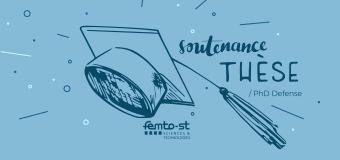You are here
- Home
- Aboubakry AGNE : Modeling and Numerical Simulation of Debinding and Sintering Steps of the Metallic Powder Injection Molding Process

Aboubakry AGNE : Modeling and Numerical Simulation of Debinding and Sintering Steps of the Metallic Powder Injection Molding Process
Friday 27th of september 2019 at 10h15B Avenue des Montboucons
25030 Besançon cedex
France
PhD Work : Modeling and Numerical Simulation of Debinding and Sintering Steps of the Metallic Powder Injection Molding Process
Abstract :The debinding and sintering steps are crucial for the Metal Injection Moulding (MIM) process. The main dimensional changes are generated from these two steps. In order to predict the mass losses and the deformation behaviours, different models fitting to the mechanical mechanisms observed were obtained from the state of art. They are adapted and performed for each step. These models used for the numerical simulation are applied to industrial components based on a formulation composed of Inconel 718 superalloy powders and a multi-ingredient binder system. The formulation is characterized by thermal and gravimetric analyses. The aim of the thesis is, at first, to predict the weight loss after the complete debinding step including the solvent and the thermal debinding, followed by the modelling of the solid state sintering of the material. The weight loss during solvent debinding is expressed by an analytic function controlled by a diffusion parameter, which is directly identified from experimental results. Hygroscopic swelling and thermal expansion are coupled to the weight loss to follow as well the expansion during the binder extraction. Supercritical debinding, an innovative way to remove by diffusion some polymers, is also investigated in order to predict the extraction of the polyethylene glycol (PEG) in in-house components by numerical simulation using the finite-element method on Comsol Multiphysics ® software. Thermogravimetric analyses were employed to characterize the kinetics during the thermal debinding of the industrial formulation. The Ozawa and Kissinger methods are introduced to estimate the activation energies of each polymer of the binder system for the numerical simulation. A coupled model is developed by using the heat transfer principle and a thermal degradation law in order to visualize the binder distribution and the shrinkage due to its elimination. Experimental and numerical studies are carried out on solid state sintering of the Inconel 718. A thermal elasto-viscoplastic law based on the continuum mechanics is adopted and built in the commercial software ABAQUS ® to simulate the shrinkage and the density field during the sintering step. The uniaxial viscosity, a main parameter of the constitutive equations, is evaluated using intermittent compression tests. The sintering stress is identified from experimental densification thanks to the viscosity and then, used for the numerical simulation. The relevance of this methodology is discussed by comparison with a different method based on the densification rate that showed a lower level of uncertainties. The numerical analysis of the debinding and the sintering steps showed in this thesis are compared with the experimental
Jury members :
Mr Didier Bouvard, Full Professor, l’University of Grenoble - Alpes, Reporter
Mr Jean Marc Haudin, Emeritus Professor at École des Mines ParisTech, Reporter
Mr, Richard, Sébastien Engineer at R&T à SAFRAN TECH, Reviewer
Mme Téresa Vieira, Full Professor at University of Coimbra, Reviewer
Mr Thierry Barrière, Full Professor at University of Franche-Comté, PhD Supervisor
Mr Yves Bienvenu, Emeritus Professeur Émérite at École des Mines ParisTech, Reviewer
Mr Jean-Marc Chaix, CNRS Research Director at Grenoble INP – Phelma, Reviewer
Mr Jean-Michel Bergheau, Full Professor at l’ENISE, Reviewer
Location : Amphithéâtre J-J Gagnepain à TEMIS Sciences, 15B, Avenue des Montboucons – Besançon









